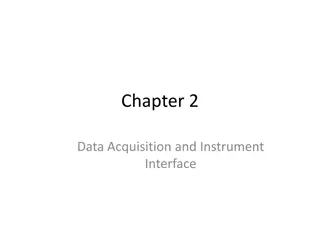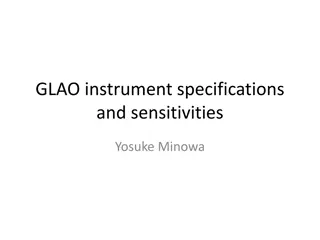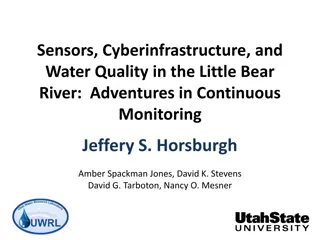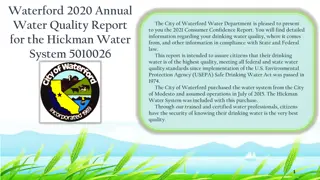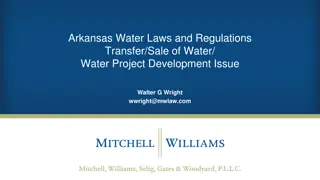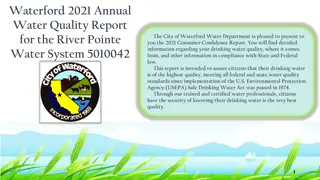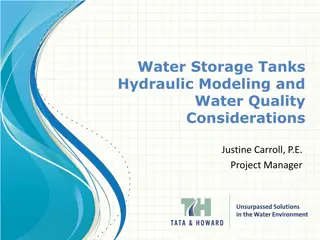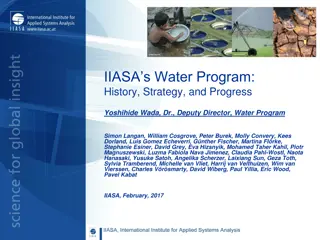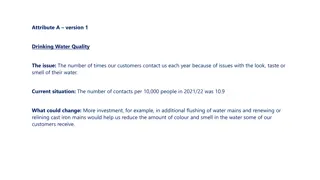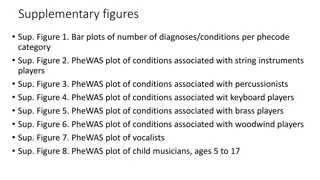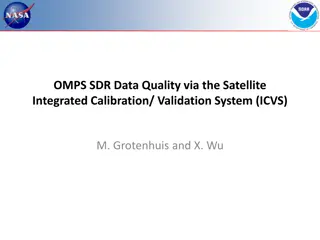Water Quality Analysis Results and Instrument Specifications
Water quality analysis results including resistivity, TOC levels, particle counts, and instrument specifications for a water purification system. The analysis shows values for resistivity, TOC levels, particle size distribution, temperature, pressure, flow rates, and more. Various instruments from Mettler-Toledo and GE are used for monitoring and analysis.
Download Presentation

Please find below an Image/Link to download the presentation.
The content on the website is provided AS IS for your information and personal use only. It may not be sold, licensed, or shared on other websites without obtaining consent from the author.If you encounter any issues during the download, it is possible that the publisher has removed the file from their server.
You are allowed to download the files provided on this website for personal or commercial use, subject to the condition that they are used lawfully. All files are the property of their respective owners.
The content on the website is provided AS IS for your information and personal use only. It may not be sold, licensed, or shared on other websites without obtaining consent from the author.
E N D
Presentation Transcript
Parameter Specification Weekly Average Resistivity 18.2 Mohm-cm 18.22 Total Organic Carbon (TOC) 2 ppb 1.35 Particles Counts Average Max Chanel 1: .05-.1 um 1000 counts/L 6.35 120 Chanel 2: .1-.15 um 350 counts/L 1.33 19 Chanel 3: .15-.2 um 350 counts/L 0 0 Chanel 4: >.2 um 20 counts/L 0 1 Temperature ( F) Pressure (psi) Flow (gpm) AUPW (Ambient) 70 70 89 HUPW (Hot) 176 66 17
Resistivity (MOhm-cm) TOC (ppb) Maximum Value 3.5 18.23 Minimum Value 0.1 18.2 Average 1.070 18.214 Std. Deviation 0.316 0.006 Instrument: Res. Mettler-Toledo (Thorton): Model 230 sensor, Model 770Max Analyzer TOC- GE (Sievers) Model 900 On-Line
Resistivity Spec = >18.2 Mohm-cm TOC Spec = < 2.0 ppb
UPW Particles (cts/L) .05-.10 um .10-.15um .15-.2um >.2um Maximum Value 94 14 1 0 Minimum Value 0 0 0 0 Average 2.88 0.30 0.00 0.00 Std. Deviation 9.10 1.76 0.06 0.00 Instrument: Particle Measurement Systems (PMS) Model HSLIS 50e
0.05u to 0.10u Limit = 1000 cts/L 0.10u to 0.15u Limit = 350 cts/L 0.15u to 0.2u Limit = 350 cts/L > 0.2u Limit = 100 cts/L
Balazs Balazs E1.1 Specification E1.1 Specification E1.1 E1.1 3* 3* 1ppb 1ppb 3ppb 3ppb E1.1 (ppb) E1.1 (ppb) 0.05 0.05 0.05 0.05 0.05 0.05 0.05 0.05 0.05 0.05 0.05 0.05 0.05 0.05 0.1 0.1 E1.1 (ppb) E1.1 (ppb) 0.02 0.02 0.02 0.02 0.1 0.1 0.02 0.02 0.02 0.02 0.02 0.02 0.02 0.02 0.02 0.02 0.02 0.02 0.02 0.02 0.02 0.02 0.02 0.02 0.02 0.02 0.02 0.02 0.02 0.02 0.02 0.02 Item Description Item Description Bacteria Bacteria- -ASTM Method ASTM Method- -48 Hr Incubation Low Low- -level Dissolved Silica level Dissolved Silica Total Silica Total Silica Anions Anions Anions by IC (UltraPure) Anions by IC (UltraPure) Anions by IC (UltraPure) Anions by IC (UltraPure) Anions by IC (UltraPure) Anions by IC (UltraPure) Anions by IC (UltraPure) Anions by IC (UltraPure) Anions by IC (UltraPure) Anions by IC (UltraPure) Anions by IC (UltraPure) Anions by IC (UltraPure) Anions by IC (UltraPure) Anions by IC (UltraPure) Single Ion by IC (NH4) Single Ion by IC (NH4) Metals Metals 30 Elements Low Level in UPW by ICP 30 Elements Low Level in UPW by ICP- -MS 30 Elements Low Level in UPW by ICP 30 Elements Low Level in UPW by ICP- -MS 30 Elements Low Level in UPW by ICP 30 Elements Low Level in UPW by ICP- -MS 30 Elements Low Level in UPW by ICP 30 Elements Low Level in UPW by ICP- -MS 30 Elements Low Level in UPW by ICP 30 Elements Low Level in UPW by ICP- -MS 30 Elements Low Level in UPW by ICP 30 Elements Low Level in UPW by ICP- -MS 30 Elements Low Level in UPW by ICP 30 Elements Low Level in UPW by ICP- -MS 30 Elements Low Level in UPW by ICP 30 Elements Low Level in UPW by ICP- -MS 30 Elements Low Level in UPW by ICP 30 Elements Low Level in UPW by ICP- -MS 30 Elements Low Level in UPW by ICP 30 Elements Low Level in UPW by ICP- -MS 30 Elements Low Level in UPW by ICP 30 Elements Low Level in UPW by ICP- -MS 30 Elements Low Level in UPW by ICP 30 Elements Low Level in UPW by ICP- -MS 30 Elements Low Level in UPW by ICP 30 Elements Low Level in UPW by ICP- -MS 30 Elements Low Level in UPW by ICP 30 Elements Low Level in UPW by ICP- -MS 30 Elements Low Level in UPW by ICP 30 Elements Low Level in UPW by ICP- -MS 30 Elements Low Level in UPW by ICP 30 Elements Low Level in UPW by ICP- -MS *Note: Second Sample = 0 cfu/100ml *Note: Second Sample = 0 cfu/100ml Parameter Parameter Bacteria/100mL Bacteria/100mL Silica, LL dissolved Silica, LL dissolved Silica, Total Silica, Total Units Units cfu/100ml cfu/100ml ppb (ug/L) ppb (ug/L) ppb (ug/L) ppb (ug/L) Result Result 3 3 0.2 0.2 0.7 0.7 48 Hr Incubation Fluoride (F Fluoride (F- -) ) Chloride (Cl Chloride (Cl- -) ) Nitrite (NO2 Nitrite (NO2- -) ) Bromide (Br Bromide (Br- -) ) Nitrate (NO3 Nitrate (NO3- -) ) Phosphate (HPO4=) Phosphate (HPO4=) Sulfate (SO4=) Sulfate (SO4=) Ammonium (NH4+) Ammonium (NH4+) ppb (ug/L) ppb (ug/L) ppb (ug/L) ppb (ug/L) ppb (ug/L) ppb (ug/L) ppb (ug/L) ppb (ug/L) ppb (ug/L) ppb (ug/L) ppb (ug/L) ppb (ug/L) ppb (ug/L) ppb (ug/L) ppb (ug/L) ppb (ug/L) * * * * * * * * * * * * * * * * MS MS MS MS MS MS MS MS MS MS MS MS MS MS MS MS Aluminum (Al) Aluminum (Al) Barium (Ba) Barium (Ba) Boron (B) Boron (B) Calcium (Ca) Calcium (Ca) Chromium (Cr) Chromium (Cr) Copper (Cu) Copper (Cu) Iron (Fe) Iron (Fe) Lead (Pb) Lead (Pb) Lithium (Li) Lithium (Li) Magnesium (Mg) Magnesium (Mg) Manganese (Mn) Manganese (Mn) Nickel (Ni) Nickel (Ni) Potassium (K) Potassium (K) Sodium (Na) Sodium (Na) Strontium (Sr) Strontium (Sr) Zinc (Zn) Zinc (Zn) ppt (pg/ml) ppt (pg/ml) ppt (pg/ml) ppt (pg/ml) ppt (pg/ml) ppt (pg/ml) ppt (pg/ml) ppt (pg/ml) ppt (pg/ml) ppt (pg/ml) ppt (pg/ml) ppt (pg/ml) ppt (pg/ml) ppt (pg/ml) ppt (pg/ml) ppt (pg/ml) ppt (pg/ml) ppt (pg/ml) ppt (pg/ml) ppt (pg/ml) ppt (pg/ml) ppt (pg/ml) ppt (pg/ml) ppt (pg/ml) ppt (pg/ml) ppt (pg/ml) ppt (pg/ml) ppt (pg/ml) ppt (pg/ml) ppt (pg/ml) ppt (pg/ml) ppt (pg/ml) * * * * * * * * * * * * * * * * * * * * * * * * * * * * * * * *




